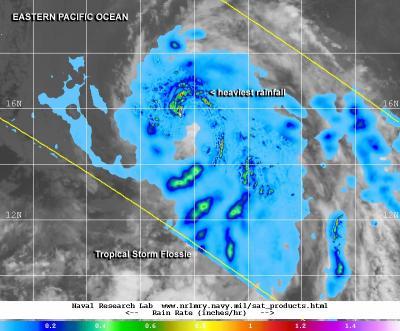As Eastern Pacific Ocean's Tropical Storm Flossie continues to move further west toward Hawaii, NASA's TRMM satellite analyzed its rainfall.
When NASA and the Japan Space Agency's Tropical Rainfall Measuring Mission or TRMM satellite passed over Tropical Storm Flossie, it measured rainfall rates occurring throughout the storm. TRMM noticed that the heaviest rainfall was occurring at a rate of 1.2 inches per hour north of the center. The heavy rain wrapped around the storm from the north to the east. Most of the remaining rainfall was light to moderate. Microwave satellite imagery shows some inner core features trying to form.
An image created at the Naval Research Laboratory, Washington, combined the TRMM data with an infrared image from NOAA's GOES-15 satellite to show rainfall within Flossie's cloud cover. Rain was falling throughout much of the storm.

This image shows TRMM rainfall data laid over an infrared image from NOAA's GOES-15 satellite to show rainfall within Flossie's cloud cover. Heaviest rainfall (red) was falling north of the center.
(Photo Credit: Image : NRL/NASA/NOAA.)
On Friday, July 26 at 8 a.m. PDT (1500 UTC) the center of Tropical Storm Flossie was located near latitude 16.1 north and longitude 132.3 west, almost mid-way between the southern tip of Baja California and Hilo, Hawaii (about 1,530 miles (2, 465 km) from each place. Maximum sustained winds were near 50 mph (85 kph). Flossie was moving to the west-northwest at 18 mph (30 kph) and had a minimum central pressure of 1,000 millibars.
As Flossie continues its westward track, the National Hurricane Center notes that residents of Hawaii should monitor the storm's approach.
Source: NASA/Goddard Space Flight Center